Seismic Response of Cable-Stayed Spanning Pipeline Considering Medium-Pipeline Fluid–Solid Coupling Dynamic Effect
Abstract
1. Introduction
2. Theory and Simulation Experiments
2.1. Prototype Structure of Oil and Gas Transmission Pipeline
2.2. Dynamics Theory and Simulation for the Seismic Response of Oil and Gas Transmission Pipeline with the Additional-Mass Method
2.2.1. Dynamics Theory for the Seismic Response of Oil and Gas Transmission Pipeline Based on Additional-Mass Method
2.2.2. Calculating the Finite Element Model for the Seismic Response of Oil and Gas Transmission Pipelines Based on the Additional-Mass Method
2.3. Dynamics Theory and Simulation for the Seismic Response of Oil and Gas Transmission Pipeline with the Fluid–Solid Coupling Effect
2.3.1. Dynamics Theory for the Seismic Response of Oil and Gas Transmission Pipeline Based on the Fluid–Solid Coupling Effect
2.3.2. Calculating Finite Element Model for the Seismic Response of Oil and Gas Transmission Pipelines Based on Fluid–Solid Coupling Effect
3. Analysis of Simulation Calculation Results
3.1. Cloud Atlas for the Seismic Response of the Model of Oil- and Gas-Transmission Pipeline
3.2. Analysis of the Seismic Response of the Model of Oil and Gas Transmission Pipelines
3.2.1. Seismic Response of Pipeline Cross-Section at Bridge Platform Location
- Time History Curve of Displacement Response of Pipeline Cross-Section
- 2.
- Time History Curve of Acceleration Response of Pipeline Cross-Section
- 3.
- Peak of Seismic Response of Pipeline Cross-Section at the Bridge Platform Location
3.2.2. Seismic Response at the Position of the Partial Pipeline Cross-Section
- 1.
- Time History Curve of Displacement Response of Pipeline Cross-Section
- 2.
- Time History Curve of the Acceleration Response of the Pipeline Cross-Section
- 3.
- Peak of the Seismic Response of the Partial Pipeline Cross-Section
4. Discussion
5. Conclusions
- (1)
- In the seismic response of the oil pipeline cross-section considering the medium–pipeline flow–solid coupling effect, the influence of the oil pipeline flow–solid coupling effect on the seismic response is more complicated; the seismic response of the pipe section is the smallest at the location of the main tower and the bridge platform on both sides, and the seismic response of the pipe section is the largest at one-fifth of the bridge platform on the left side.
- (2)
- In the seismic response of the pipeline cross-section at the bridge location, the seismic response at point B in the pipeline cross-section reached the maximum; the peak of the seismic response of the pipeline cross-section at the left bridge platform was slightly larger than that at the right bridge platform, related to the propagation direction of seismic waves.
- (3)
- As for the seismic response of the pipe section at different locations, the seismic response at point D in the pipe section reached the maximum, corresponding to the seismic response of the pipe section at the bridge platform location; the changing trend of seismic displacement and acceleration response based on the fluid–solid coupling method was more stable, while the changing trend of the seismic response of the oil pipeline cross-section using the additional-mass method increased first and then decreased. Most of the seismic response of the oil pipeline based on the fluid–solid coupling effect was smaller than that of the additional-mass method because of the viscoelastic damping effect of the medium in the pipeline. The peak variation range of the seismic response of the pipeline using the additional-mass method was much larger than that of the seismic response based on the fluid–solid coupling effect; the maximum displacement response of the pipeline section using the additional-mass method was increased by 24%, and the maximum acceleration response was increased by 30%.
- (4)
- The coupling effect considering the mass of the oil and gas transmission medium and the viscoelastic effect had a weakening effect on the seismic response of the oil and gas transmission pipeline, while the additional-mass method without considering the viscoelastic effect of the medium exaggerated the seismic response of the cable-stayed spanning type oil transmission pipeline, whereby the calculation results were on the conservative side, and the design of the project was on the safe side.
Author Contributions
Funding
Data Availability Statement
Conflicts of Interest
References
- Hao, J.; Liu, P.; Zhang, J.; Jing, Y.; Han, B.; Wu, Z. Risk of Earthquake Hazard to Long-distance Oil and Gas Pipelines. Oil Gas Storage Transp. 2009, 28, 27–30. [Google Scholar]
- Xiao, B.; Zhou, Y.; Gao, C.; Cao, Y.; Shi, S.; Liu, Z. Analysis of vibration characteristics of pipeline with fluid added mass. J. Vib. Shock. 2021, 40, 182–188. [Google Scholar] [CrossRef]
- Li, J.; Zhang, D.; Wang, L.; Lin, D.; Hong, J. Modal characteristics analysis for pipelines considering influence of fluid medium. J. Aerosp. Power 2019, 34, 671–677. [Google Scholar] [CrossRef]
- Dante, D.; Afaque, S. Scaling of added mass and added damping of cylindrical rods by means of FSI simulations. J. Fluids Struct. 2019, 88, 241–256. [Google Scholar] [CrossRef]
- Zhou, Y.; Li, Y.; Yu, Z.; Yoshida, A. Study on added mass of a circular curved membrane vibrating in still air. Thin-Walled Struct. 2018, 127, 200–209. [Google Scholar] [CrossRef]
- Zhao, Q.; Sun, Z. Flow-induced vibration of curved pipe conveying fluid by a new transfer matrix method. Eng. Appl. Comput. Fluid Mech. 2018, 12, 780–790. [Google Scholar] [CrossRef]
- Xu, J.; Fan, Y. Finite Element Analysis of Seismic Response of Two-Span Aqueduct with Fluid-Structure Coupling. Yellow River 2012, 34, 95–97. [Google Scholar] [CrossRef]
- Wang, L.; Zhang, J.; Zhang, H.; Zhang, R. Seismic response analysis of buried water supply pipeline based on fluid-solid interaction. J. Shenzhen Univ. Sci. Eng. 2020, 37, 271–278. [Google Scholar] [CrossRef]
- Wylie, E.; Streeter, V.; Wiggert, D. Multidimensional Fluid Transients by Latticework. J. Fluids Eng. 1980, 102, 384–385. [Google Scholar] [CrossRef]
- Farhat, C.; Geuzaine, P.; Brown, G. Application of a three-field nonlinear fluid-structure formulation to the pre-diction of the aeroelastic parameters of an F-16 fighte. Comput. Fluids 2003, 32, 3–29. [Google Scholar] [CrossRef]
- Nieto, F.; Hargreaves, D.; Owen, J.; Hernández, S. On the applicability of 2D URANS and SST k-ω turbulence model to the fluid-structure interaction of rectangular cylinders. Eng. Appl. Comput. Fluid Mech. 2015, 9, 157–173. [Google Scholar] [CrossRef]
- Wang, Z.; He, Y.; Li, M.; Qiu, M.; Huang, C.; Liu, Y.; Wang, Z. Numerical Investigation on Dynamic Response Characteristics of Fluid-Structure Interaction of Gas-Liquid Two-Phase Flow in Horizontal Pipe. J. Shanghai Jiaotong Univ. Sci. 2022, 1–8. [Google Scholar] [CrossRef]
- Guo, Q.; Zhou, J.; Guan, X. Fluid–structure interaction in Z shaped pipe with different supports. Acta Mech. Sin. 2020, 36, 513–523. [Google Scholar] [CrossRef]
- Rakhsha, M.; Yang, L.; Hu, W.; Negrut, D. On the use of multibody dynamics techniques to simulate fluid dynamics and fluid–solid interaction problems. Multibody Syst. Dyn. 2021, 53, 29–57. [Google Scholar] [CrossRef]
- Liu, X.; Liu, L. An immersed transitional interface finite element method for fluid interacting with rigid/deformable solid. Eng. Appl. Comput. Fluid Mech. 2019, 13, 337–358. [Google Scholar] [CrossRef]
- Wang, X.; Yang, S.; Tao, Y. Model studies of fluid-structure interaction problems. CMES Comput. Model. Eng. Sci. 2019, 119, 5–34. [Google Scholar] [CrossRef]
- Richter, T.; Wick, T. Finite elements for fluid–structure interaction in ALE and fully Eulerian coordinates. Comput. Methods Appl. Mech. Eng. 2010, 199, 2633–2642. [Google Scholar] [CrossRef]
- Wu, J.; Zheng, S.; Wang, C.; Yu, Z. Study on pipeline self-excited vibration using transient fluid-structure coupling method. Int. J. Adv. Manuf. Technol. 2020, 107, 4055–4068. [Google Scholar] [CrossRef]
- Wang, Z.; He, Y.; Li, M.; Qiu, M.; Huang, C.; Liu, Y.; Wang, Z. Fluid−Structure Interaction of Two-Phase Flow Passing Through 90°Pipe Bend Under Slug Pattern Conditions. China Ocean. Eng. 2021, 35, 914–923. [Google Scholar] [CrossRef]
- Benedikt, S.; Christoph, A.; Wolfgang, A. Monolithic cut finite element–based approaches for fluid-structure interaction. Int. J. Numer. Methods Eng. 2019, 119, 757–796. [Google Scholar] [CrossRef]
- Gu, Z.; Bai, C.; Zhang, H. Stochastic Finite-Element Modeling and Dynamic Characteristics Analysis of Pipe-Conveying Fluid. J. Vib. Eng. Technol. 2019, 7, 251–259. [Google Scholar] [CrossRef]
- Andrade, D.; Freitas, R.; Tijsseling, A. A new model for fluid transients in piping systems taking into account the fluid–structure interaction. J. Fluids Struct. 2022, 114, 103720. [Google Scholar] [CrossRef]
- Liang, C.; Guo, Z.; Wang, C. The Connection between flow pattern evolution and vibration in 90-degree pipeline: Bidirectional fluid-structure interaction. Energy Sci. Eng. 2022, 10, 308–323. [Google Scholar] [CrossRef]
- Singh, K.; Sadeghi, F.; Russell, T.; Lorenz, S.J.; Peterson, W.; Villarreal, J.; Jinmon, T. Fluid–Structure Interaction Modeling of Elastohydrodynamically Lubricated Line Contacts. J. Tribol. 2021, 143, 091602. [Google Scholar] [CrossRef]
- Teng, Z.; Liu, Q.; Ten, Y.; Zhao, Y.; Ji, J. Seismic response of buried oil pipeline based on heat fluid-solid multi-fields coupling. J. Northeast. Pet. Univ. 2021, 45, 99–110. [Google Scholar] [CrossRef]
- Bhavana, V.; Samit, R.; Prishati, R. Seismic response of an elevated aqueduct considering hydrodynamic and soil-structure interactions. Int. J. Adv. Struct. Eng. 2016, 8, 53–71. [Google Scholar] [CrossRef]
- Li, Q.; He, S. Research on Effect Factors of Mechanical Response of Cross-Fault Buried Gas Pipeline Based on Fluid-Structure Interaction. J. Press. Vessel. Technol. 2021, 143, 061402. [Google Scholar] [CrossRef]
- Vieir, J.; Akhiiartdinov, A.; Sævik, S.; Larsen, C.; Nydal, O. Two-way coupled fluid-structure interaction of gas-liquid slug flow in a flexible riser: Small-scale experiments and simulations. Multiph. Sci. Technol. 2019, 31, 17–43. [Google Scholar] [CrossRef]
- Deng, Y.; Guo, Q.; Xu, L. Effects of Pounding and Fluid–Structure Interaction on Seismic Response of Long-Span Deep-Water Bridge with High Hollow Piers. Arab. J. Sci. Eng. 2019, 44, 4453–4465. [Google Scholar] [CrossRef]
- Pan, Y.; Zhong, M. Implementation of the additional mass method in ANSYS. J. Comput. Appl. 2003, 23, 448–449. [Google Scholar]
- Peng, J.; Xi, D.; Feng, X. An ALE formulation for compressible flows based on multi-moment finite volume method. Eng. Appl. Comput. Fluid Mech. 2018, 12, 791–809. [Google Scholar] [CrossRef]

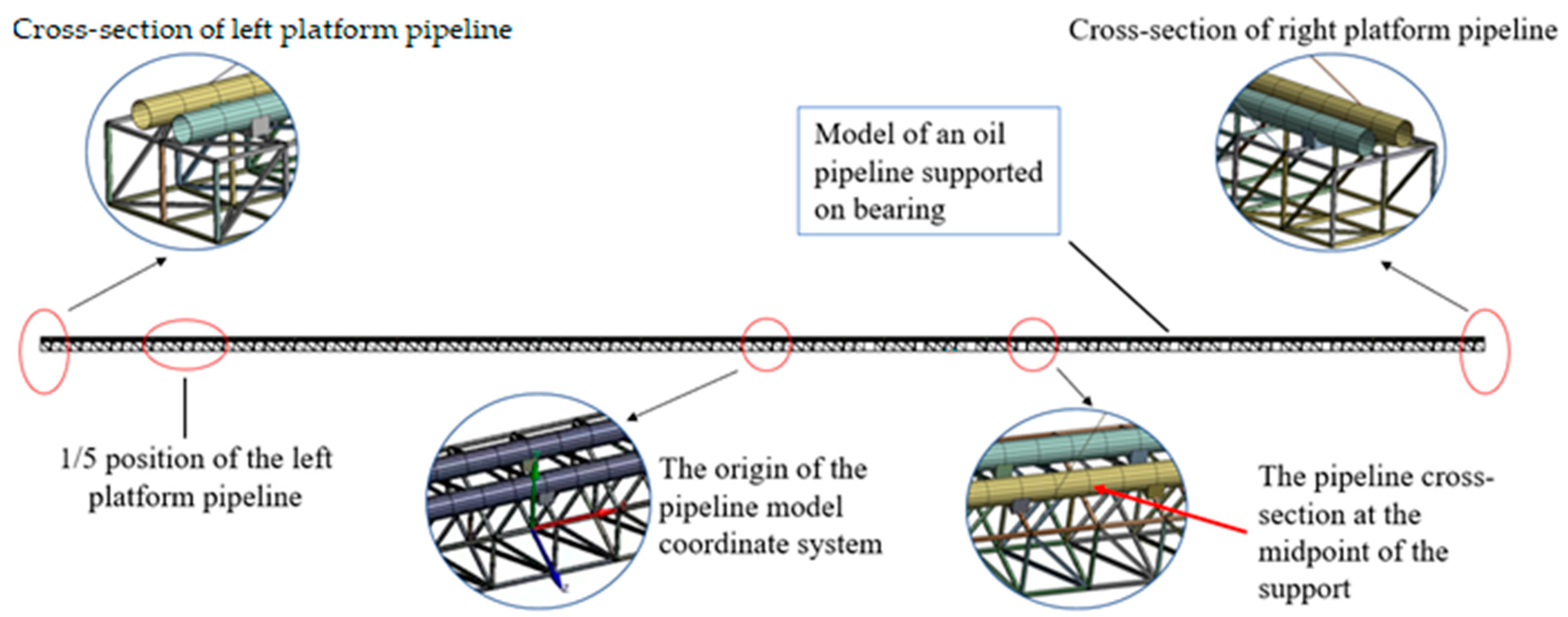
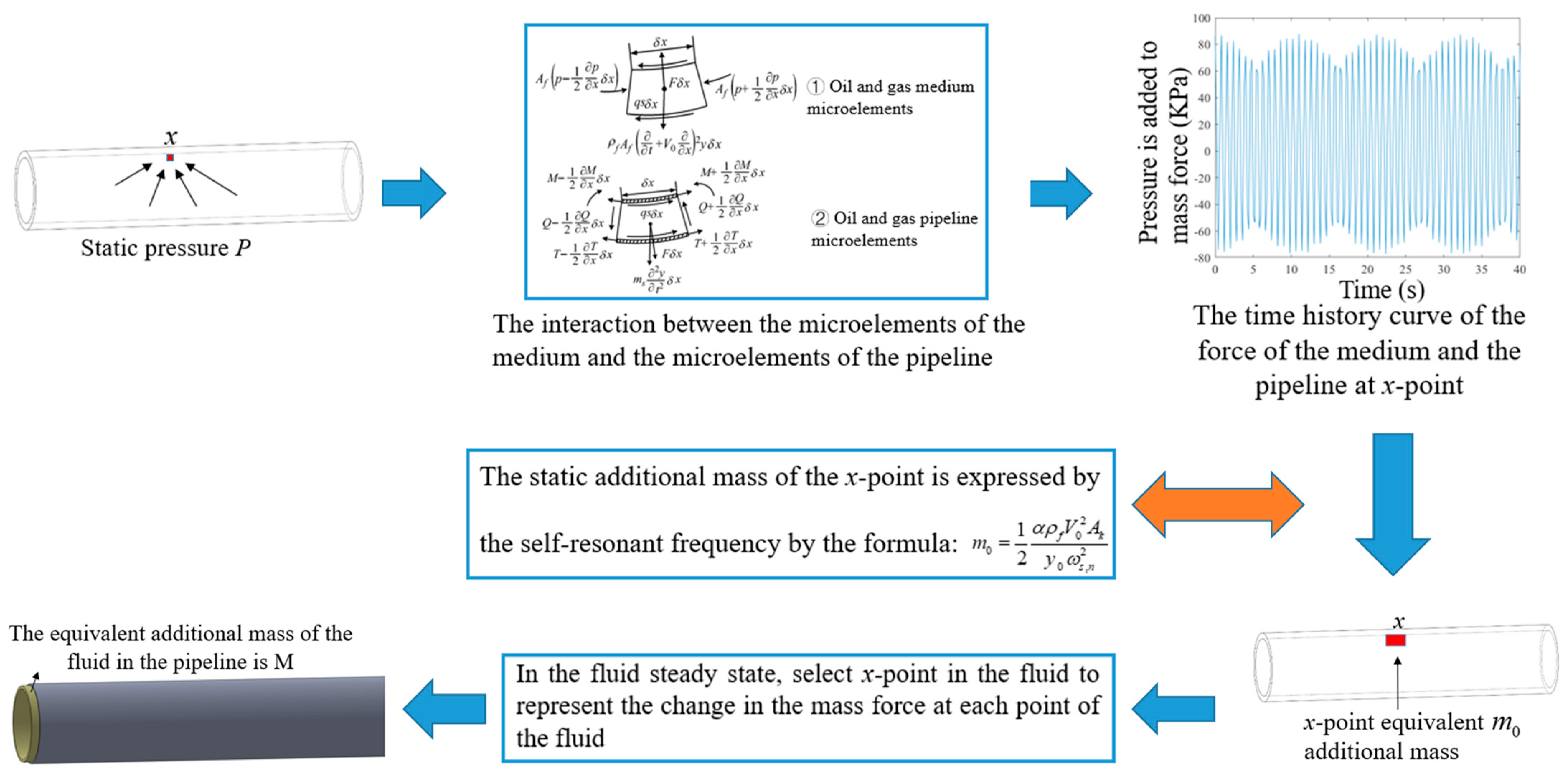

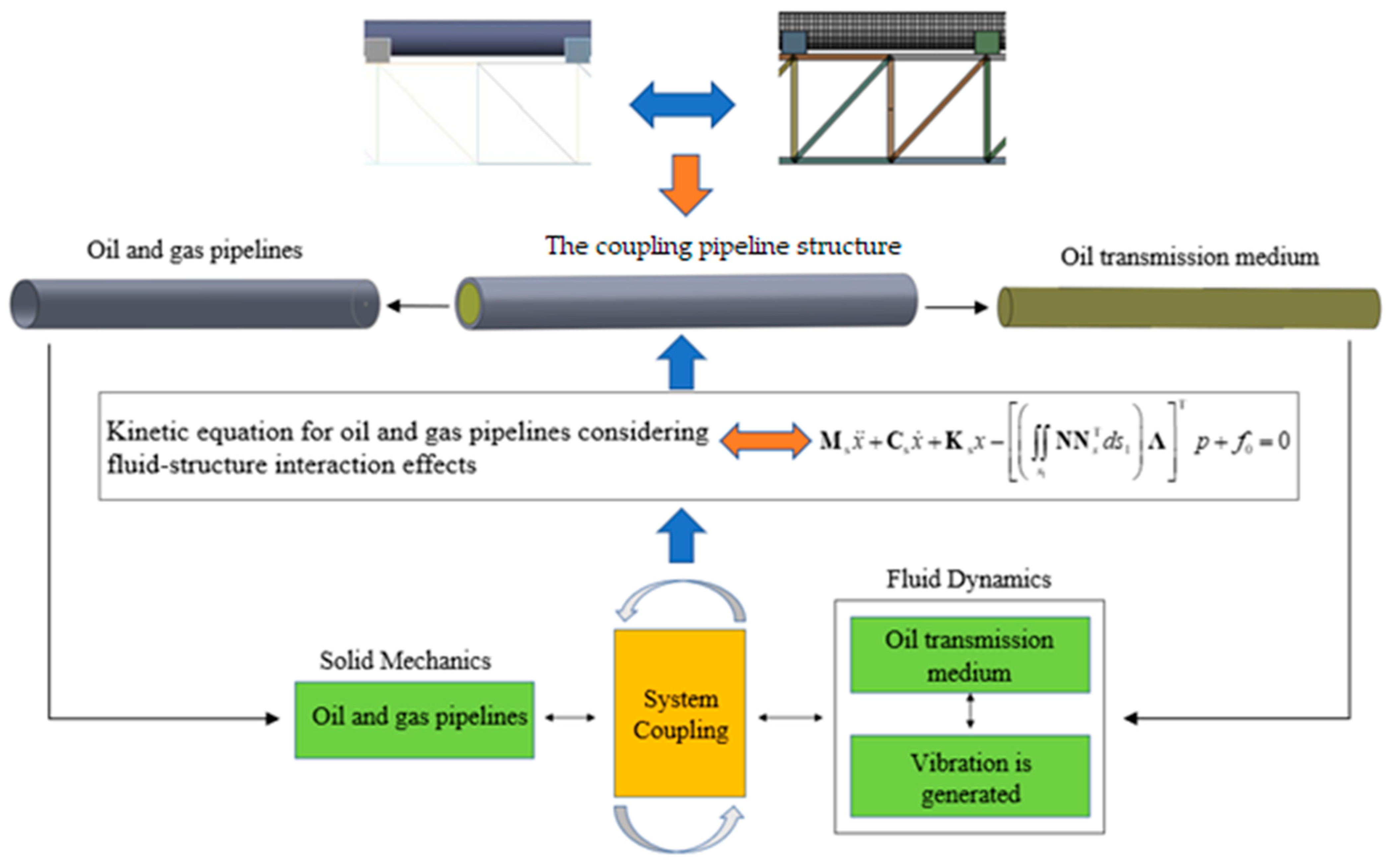
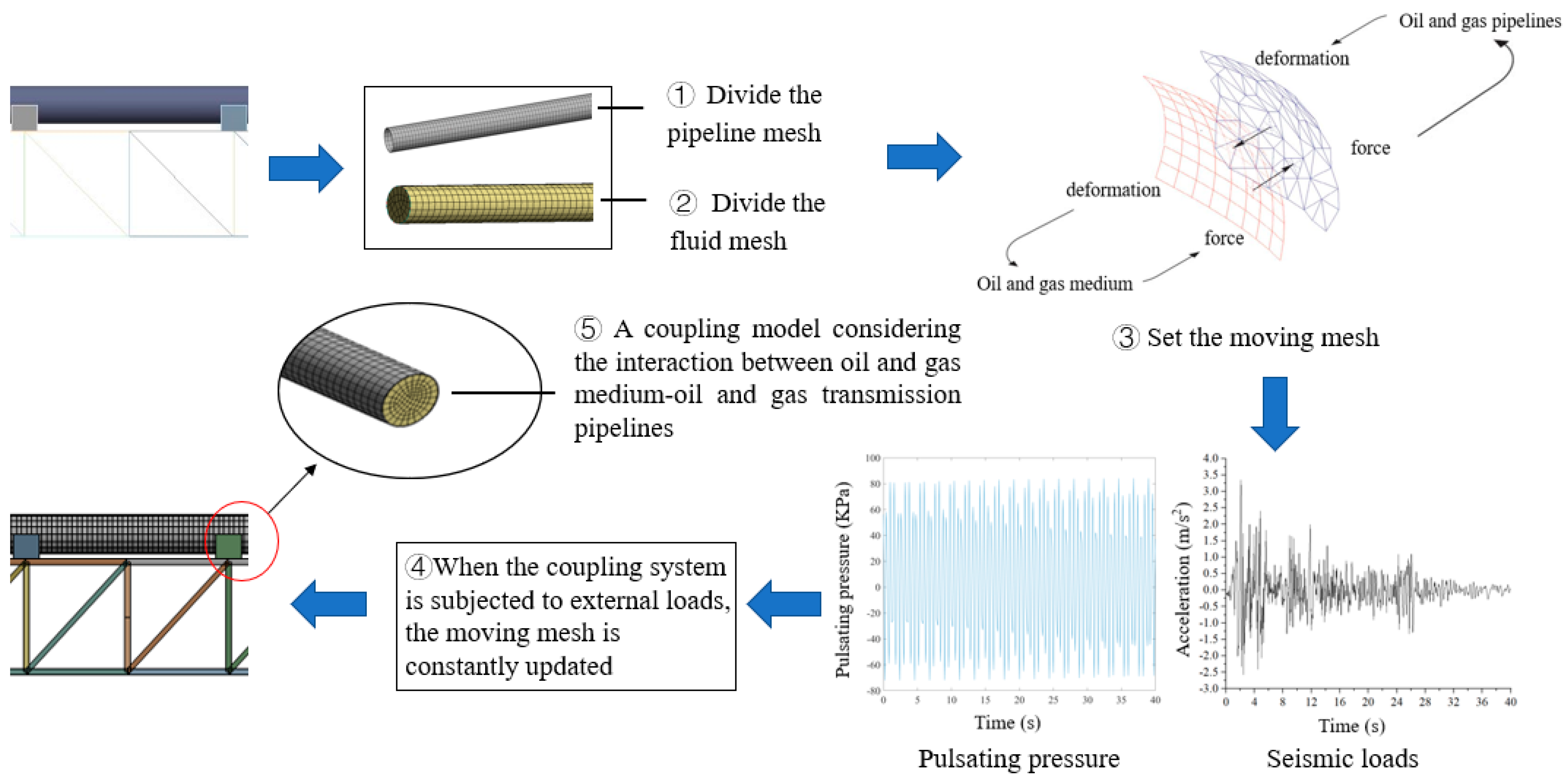

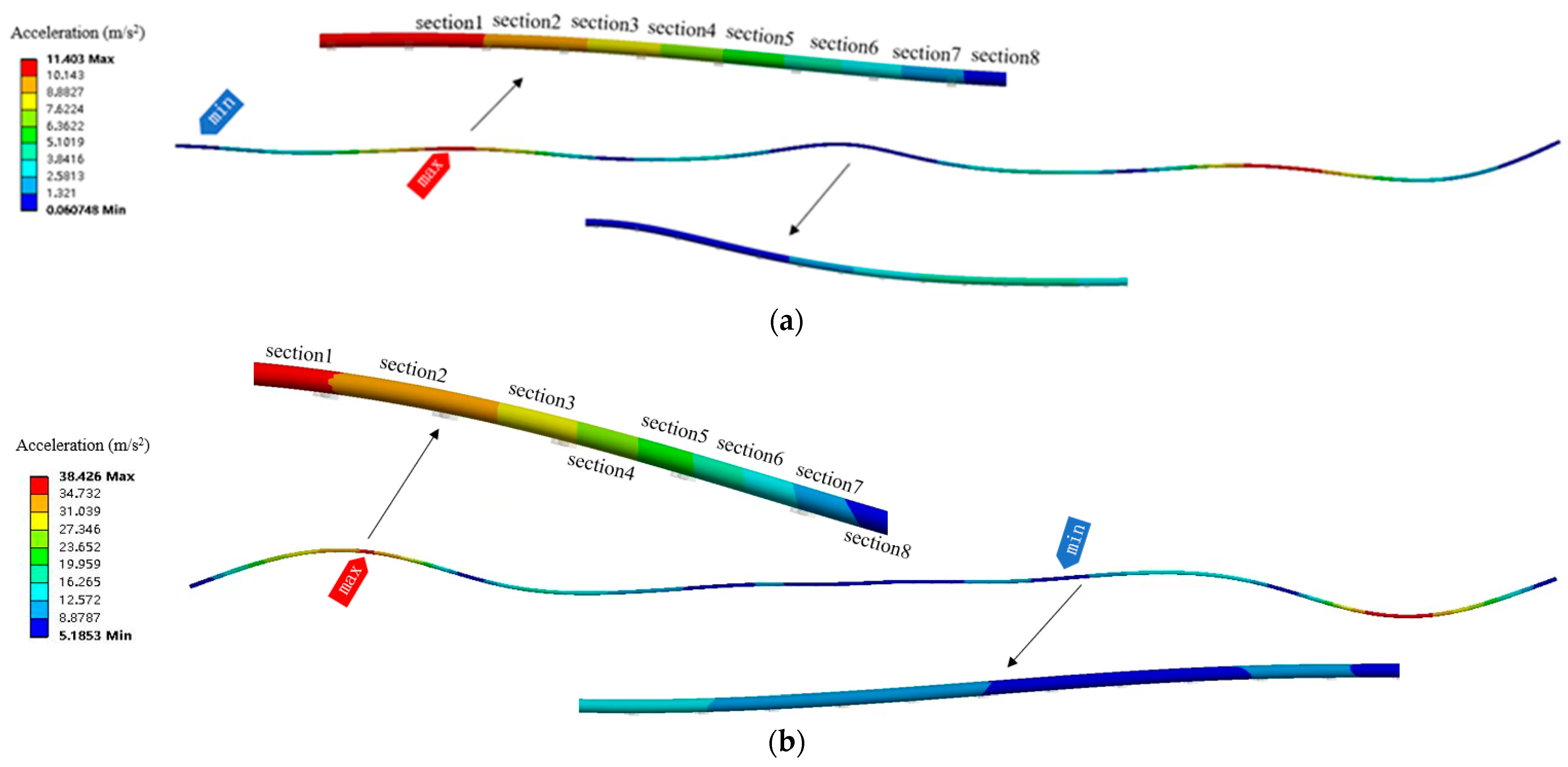
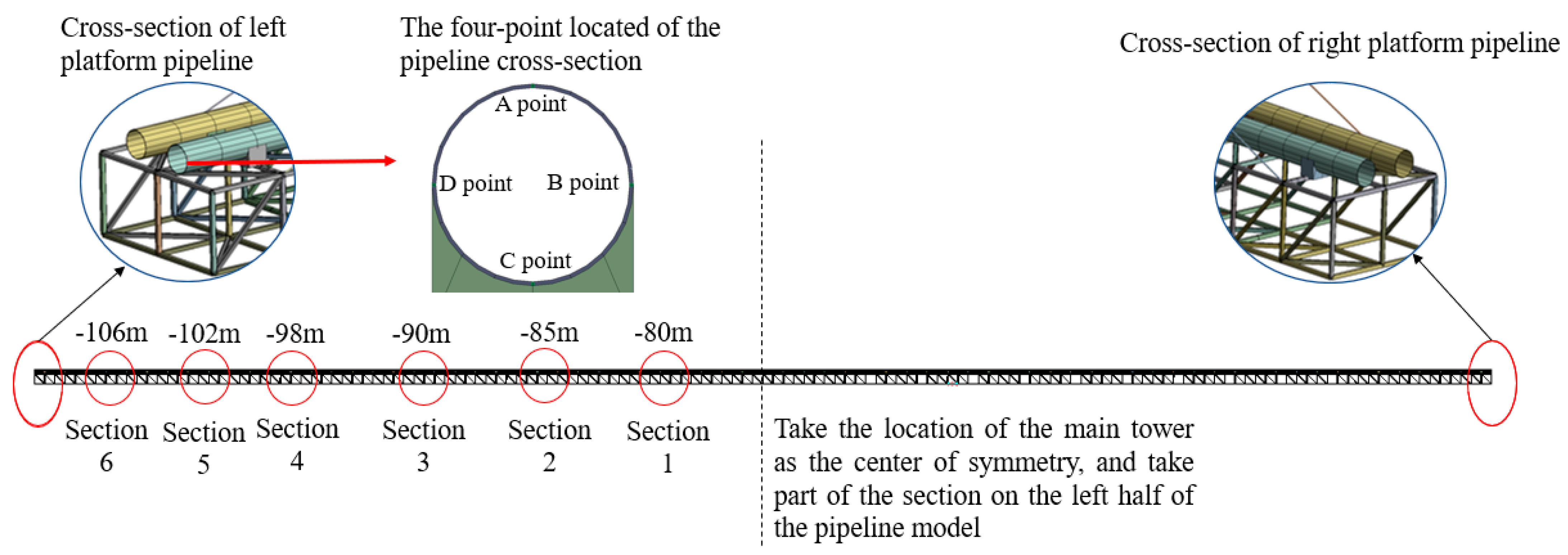
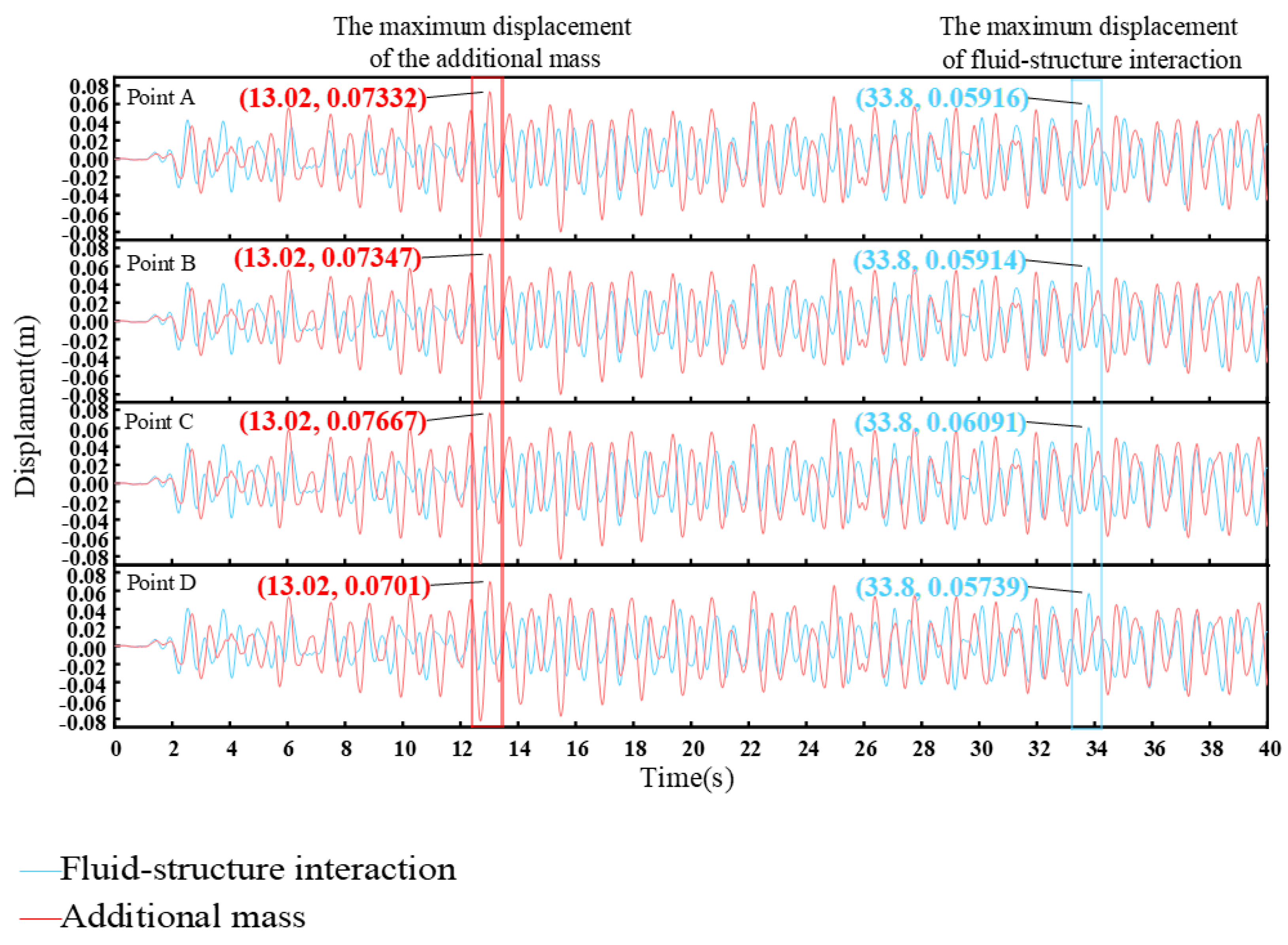
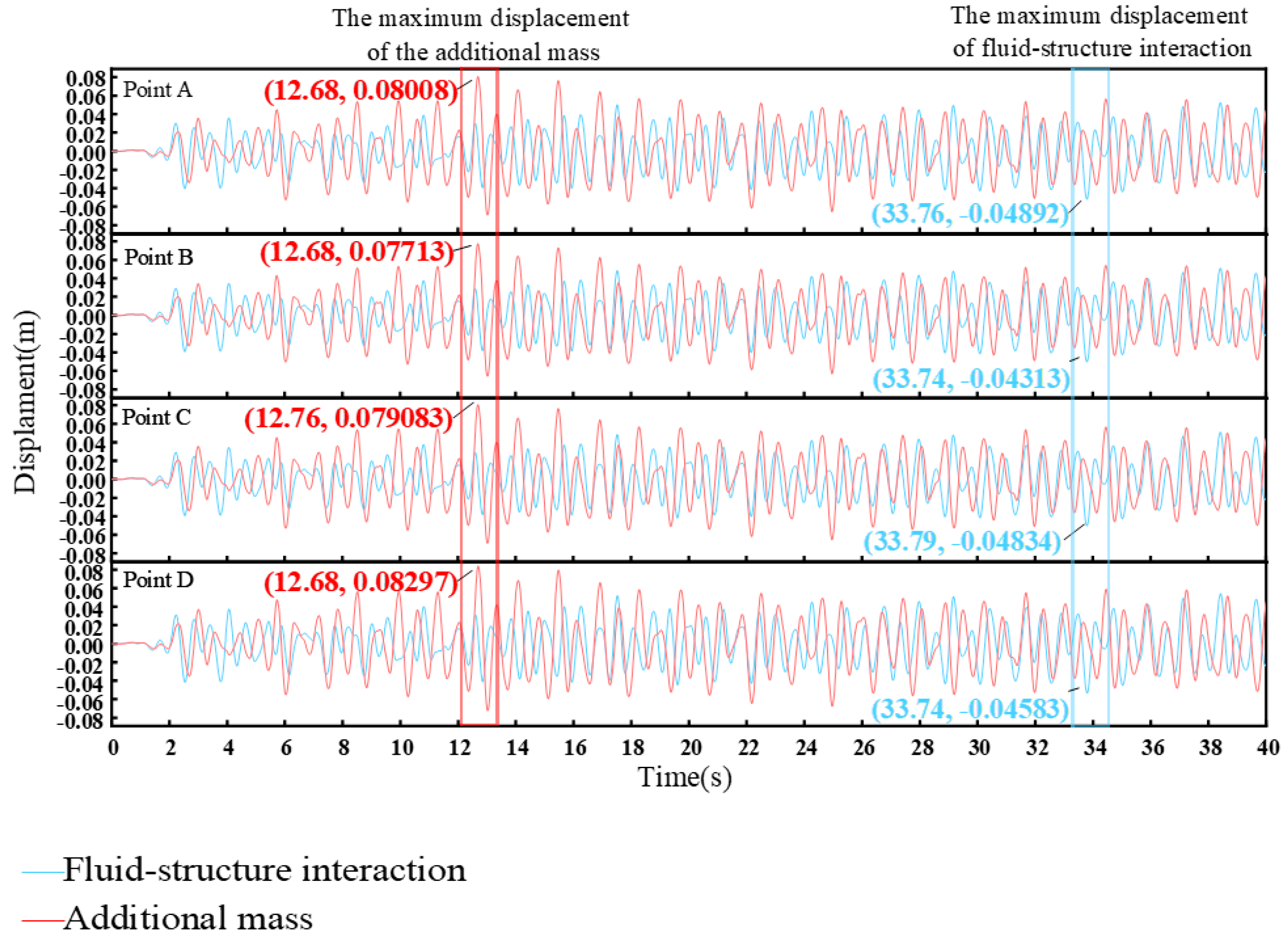
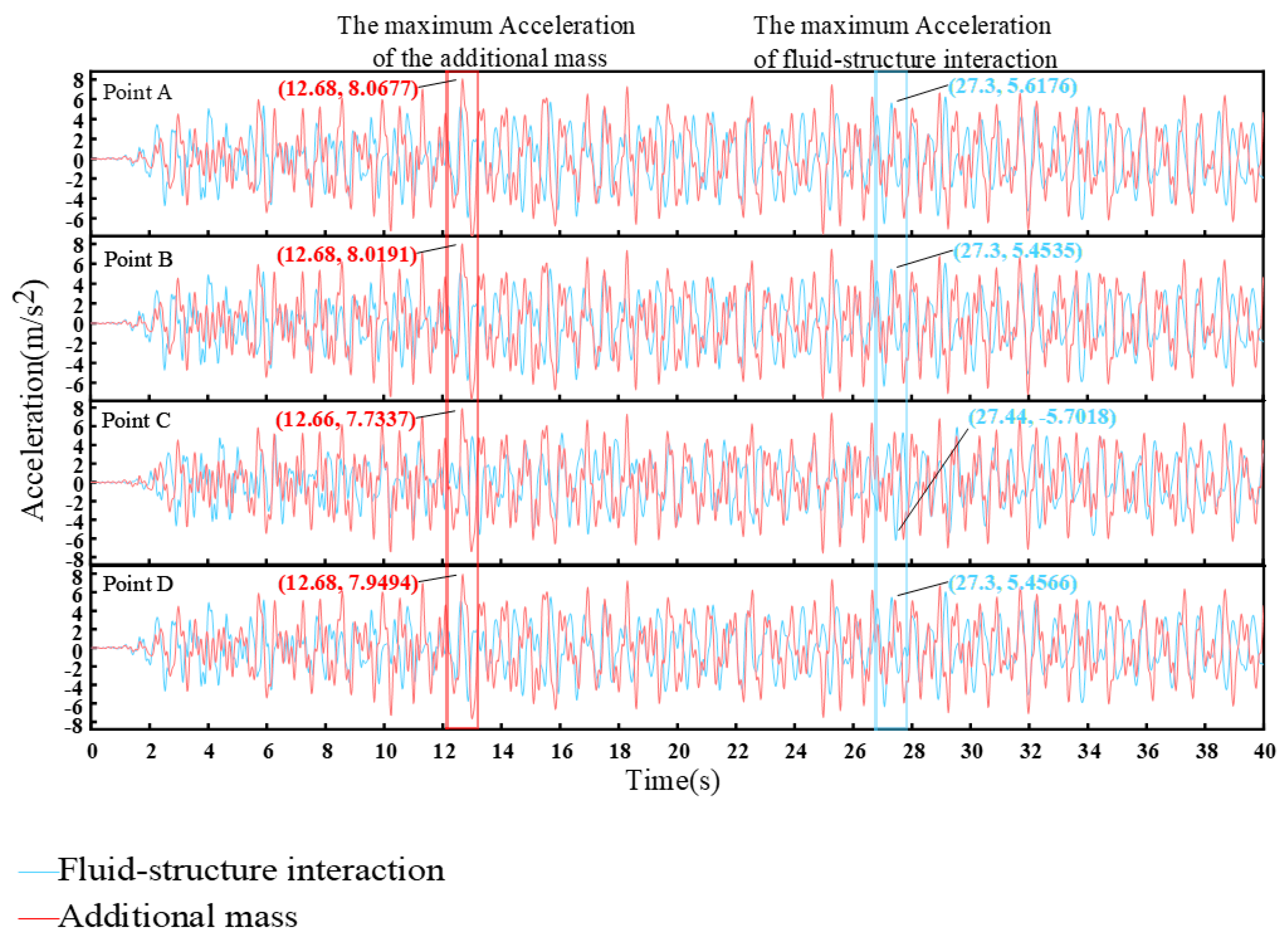

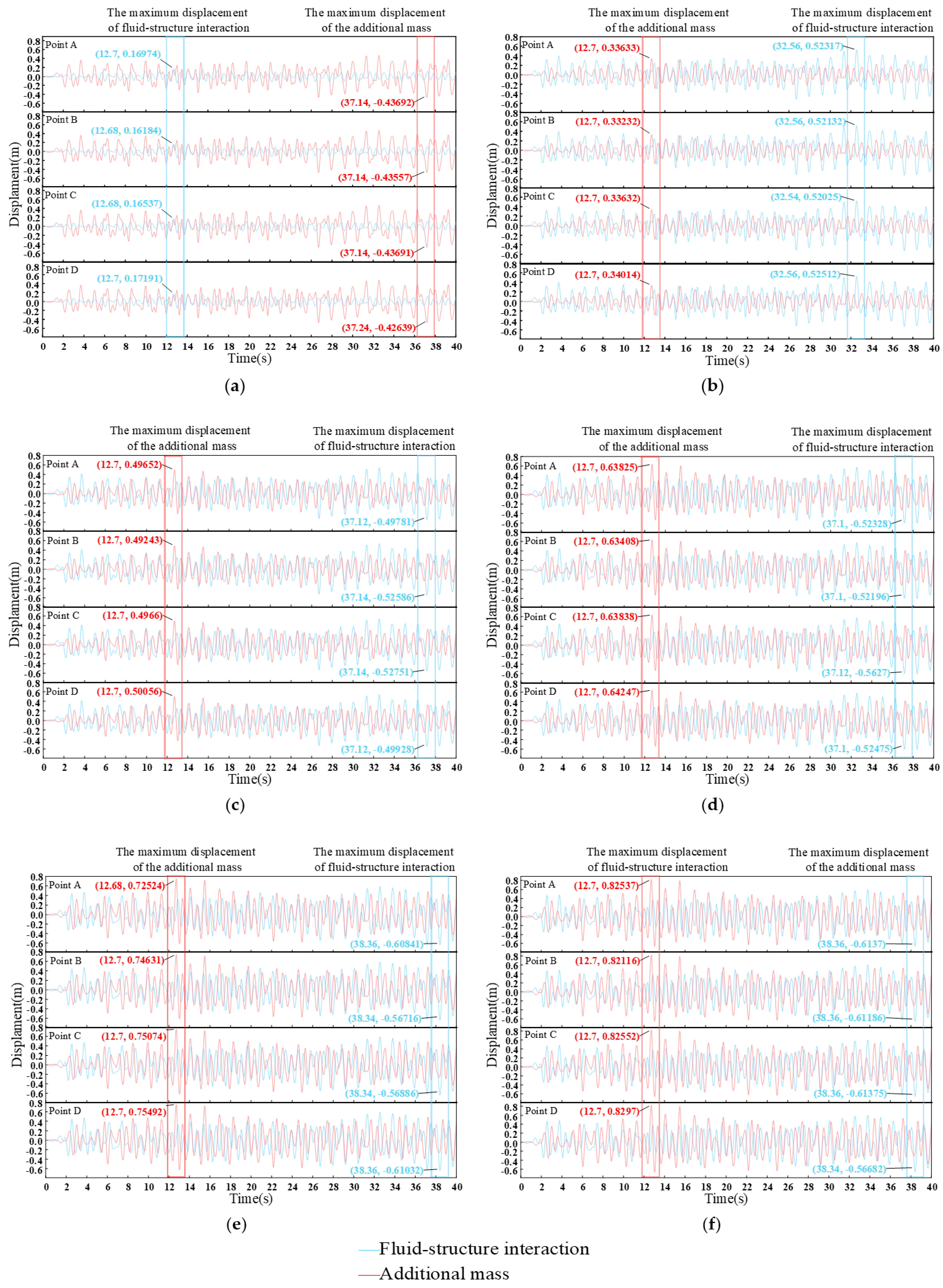
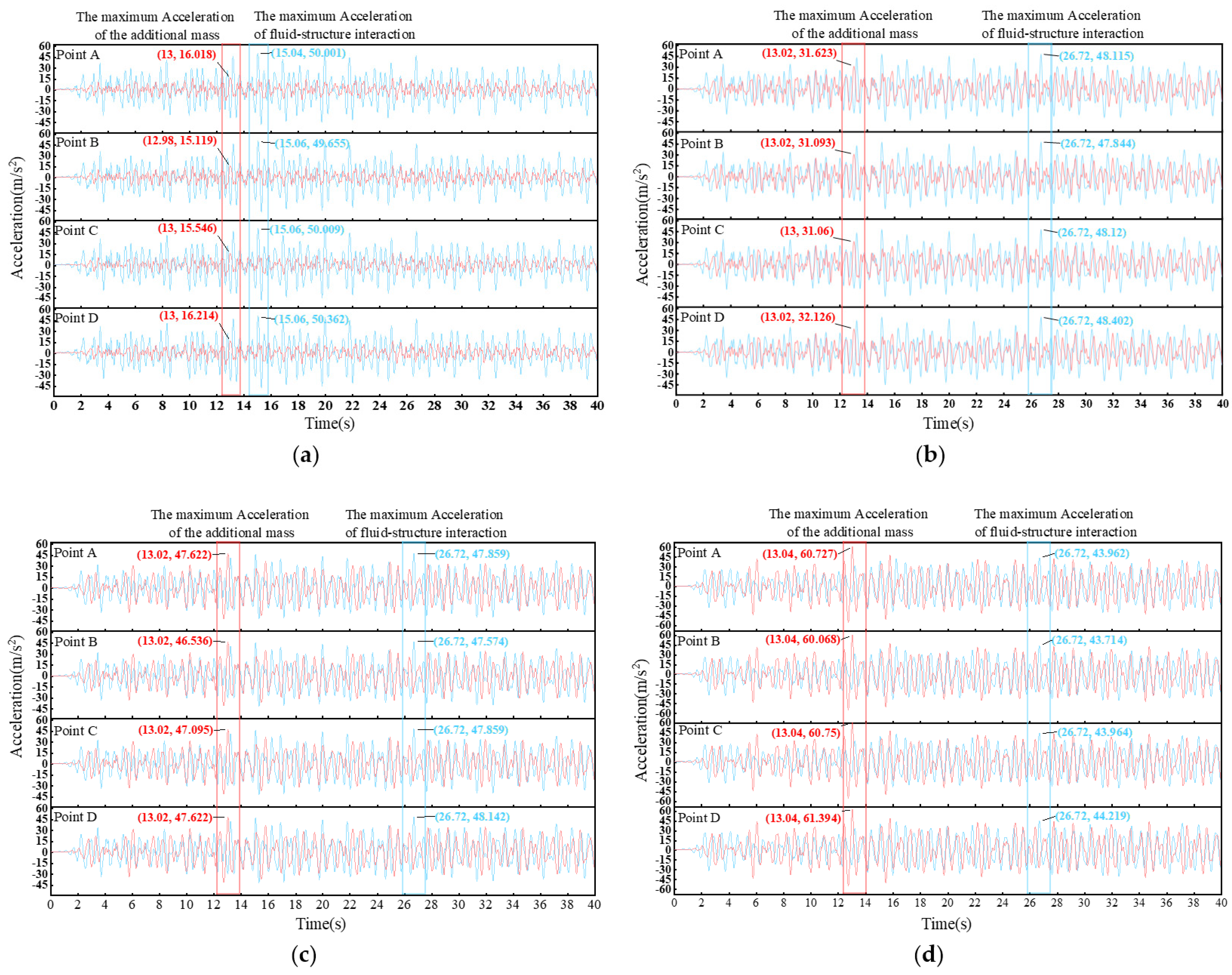
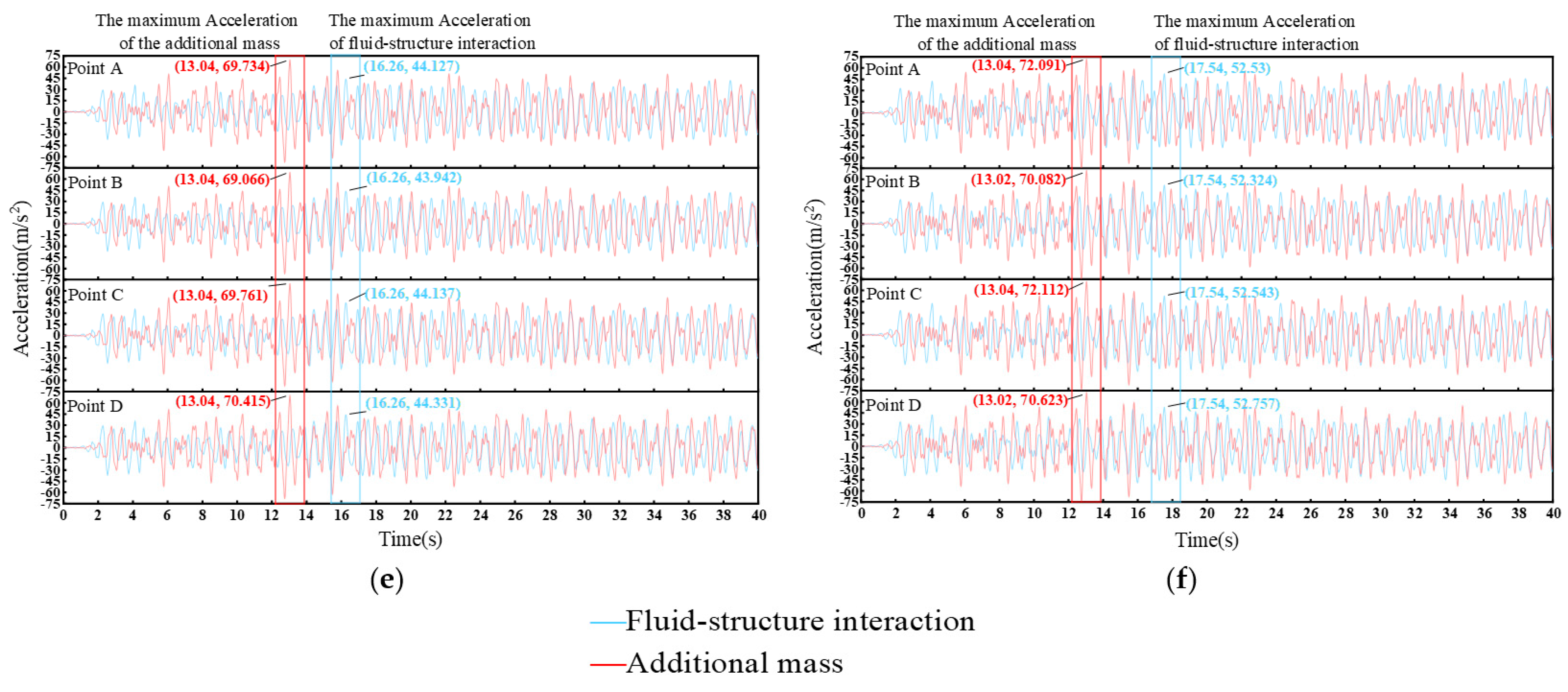
| Part | Material | Elastic Modulus (Pa) | Poisson’s Ratio | Density (Kg/m3) | Spec |
|---|---|---|---|---|---|
| Pipe | X60 | 2.06 × 1011 | 0.3 | 7850 | Φ711 × 12.7 mm |
| Support | rubber support | 0.78 × 109 | 0.47 | 0.94 | |
| Joist beam | Q345 | 2.1 × 1011 | 0.3 | 7850 | |
| Main Tower | Q345 | 2.1 × 1011 | 0.3 | 7850 | |
| Cable | 6 × 37galvanized steel wire rope | 2.06 × 1011 | 0.3 | 5200 | Φ25.5, Φ36, Φ42, Φ45 |
| Section Position | Point A | Point B | Point C | Point D | ||||
|---|---|---|---|---|---|---|---|---|
| Fluid–Solid Coupling | Additional Mass | Fluid–Solid Coupling | Additional Mass | Fluid–Solid Coupling | Additional Mass | Fluid–Solid Coupling | Additional Mass | |
| Left platform | 0.059 | −0.081 | 0.061 | −0.089 | 0.059 | −0.086 | 0.057 | −0.083 |
| Right platform | −0.050 | 0.081 | −0.053 | 0.084 | −0.052 | 0.081 | −0.050 | 0.078 |
| Section Position | Point A | Point B | Point C | Point D | ||||
|---|---|---|---|---|---|---|---|---|
| Fluid–Solid Coupling | Additional Mass | Fluid–Solid Coupling | Additional Mass | Fluid–Solid Coupling | Additional Mass | Fluid–Solid Coupling | Additional Mass | |
| Left platform | −6.38 | 7.95 | −6.55 | 8.07 | −6.38 | 8.02 | −6.10 | 7.90 |
| Right platform | 6.04 | −7.38 | 6.24 | 7.59 | 6.01 | −7.45 | 5.82 | −7.46 |
| Section | Point A | Point B | Point C | Point D | ||||
|---|---|---|---|---|---|---|---|---|
| Fluid–Solid Coupling | Additional Mass | Fluid–Solid Coupling | Additional Mass | Fluid–Solid Coupling | Additional Mass | Fluid–Solid Coupling | Additional Mass | |
| 1 | −0.472 | 0.170 | −0.470 | 0.165 | 0.471 | 0.168 | 0.437 | 0.172 |
| 2 | −0.528 | 0.336 | −0.527 | 0.332 | −0.528 | 0.336 | −0.530 | 0.340 |
| 3 | −0.549 | 0.497 | −0.543 | 0.492 | −0.549 | 0.497 | −0.551 | 0.501 |
| 4 | −0.605 | 0.638 | −0.603 | 0.634 | −0.605 | 0.638 | −0.607 | 0.642 |
| 5 | −0.639 | 0.751 | −0.637 | 0.747 | −0.639 | 0.751 | −0.641 | 0.756 |
| 6 | −0.660 | 0.825 | −0.658 | 0.821 | −0.661 | 0.826 | −0.663 | 0.830 |
| Section | Point A | Point B | Point C | Point D | ||||
|---|---|---|---|---|---|---|---|---|
| Fluid–Solid Coupling | Additional Mass | Fluid–Solid Coupling | Additional Mass | Fluid–Solid Coupling | Additional Mass | Fluid–Solid Coupling | Additional Mass | |
| 1 | 43.962 | 16.018 | 43.714 | 15.709 | 43.964 | 15.889 | 44.219 | 16.214 |
| 2 | 48.115 | 23.596 | 45.021 | 23.255 | 45.200 | 23.599 | 44.841 | 24.079 |
| 3 | 47.859 | 47.082 | 47.574 | 46.536 | 47.859 | 47.095 | 48.142 | 47.622 |
| 4 | 49.208 | 59.938 | 48.862 | 59.381 | 49.206 | 59.959 | 49.546 | 60.012 |
| 5 | 50.001 | 69.734 | 49.655 | 69.066 | 50.009 | 69.761 | 50.362 | 70.415 |
| 6 | 52.530 | 72.091 | 52.324 | 73.495 | 52.543 | 71.909 | 52.757 | 74.712 |
Disclaimer/Publisher’s Note: The statements, opinions and data contained in all publications are solely those of the individual author(s) and contributor(s) and not of MDPI and/or the editor(s). MDPI and/or the editor(s) disclaim responsibility for any injury to people or property resulting from any ideas, methods, instructions or products referred to in the content. |
© 2023 by the authors. Licensee MDPI, Basel, Switzerland. This article is an open access article distributed under the terms and conditions of the Creative Commons Attribution (CC BY) license (https://creativecommons.org/licenses/by/4.0/).
Share and Cite
Weng, G.; Xie, Q.; Xu, C.; Zhang, P.; Zhang, X. Seismic Response of Cable-Stayed Spanning Pipeline Considering Medium-Pipeline Fluid–Solid Coupling Dynamic Effect. Processes 2023, 11, 313. https://doi.org/10.3390/pr11020313
Weng G, Xie Q, Xu C, Zhang P, Zhang X. Seismic Response of Cable-Stayed Spanning Pipeline Considering Medium-Pipeline Fluid–Solid Coupling Dynamic Effect. Processes. 2023; 11(2):313. https://doi.org/10.3390/pr11020313
Chicago/Turabian StyleWeng, Guangyuan, Qixuan Xie, Chenxi Xu, Peng Zhang, and Xiang Zhang. 2023. "Seismic Response of Cable-Stayed Spanning Pipeline Considering Medium-Pipeline Fluid–Solid Coupling Dynamic Effect" Processes 11, no. 2: 313. https://doi.org/10.3390/pr11020313
APA StyleWeng, G., Xie, Q., Xu, C., Zhang, P., & Zhang, X. (2023). Seismic Response of Cable-Stayed Spanning Pipeline Considering Medium-Pipeline Fluid–Solid Coupling Dynamic Effect. Processes, 11(2), 313. https://doi.org/10.3390/pr11020313






